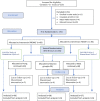'Nasal mask' in comparison with 'nasal prongs' or 'rotation of nasal mask with nasal prongs' reduce the incidence of nasal injury in preterm neonates supported on nasal continuous positive airway pressure (nCPAP): A randomized controlled trial
- PMID: 30703172
- PMCID: PMC6355017
- DOI: 10.1371/journal.pone.0211476
'Nasal mask' in comparison with 'nasal prongs' or 'rotation of nasal mask with nasal prongs' reduce the incidence of nasal injury in preterm neonates supported on nasal continuous positive airway pressure (nCPAP): A randomized controlled trial
Abstract
Background: With increasing use of nCPAP, the safety and comfort associated with nCPAP have come into the forefront. The reported incidence of nasal injuries associated with the use of nCPAP is 20% to 60%. A recent meta-analysis concluded that the use of nasal masks significantly decreases CPAP failure and the incidence of moderate to severe nasal injury and stress the need for a well powered RCT to confirm their findings.
Methods: In this Open label, 3 arms, sequential, stratified randomized controlled trial, we evaluated the incidence and severity of nasal injury at removal of nCPAP when using two different nasal interfaces and in three groups (i.e. rotation group, mask continue group, prong continue group). Preterm infants with gestation ≤ 30 weeks and respiratory distress within the first 6 hours of birth and in need of CPAP were eligible for the study.
Results: Among the 175 newborns included in the study, incidence of nasal injury in mask continue group [n = 19/57 (33.3%)] was significantly less as compared to prong continue group [n = 55/60 (91.6%)] and rotation group [33/ 58 (56.9%), p value <0.0001]. Median maximum nasal injury score was significantly less in Mask continue group as compared to Prong continue group and Rotation group [Injury Score 0 (IQR 0-1) vs. Injury Score 3 (IQR 2-5) vs. Injury Score 1 (IQR 0-2), p value = <0.0001] respectively. The proportion of infants failing nCPAP was similar across the three groups.
Conclusion: nCPAP with nasal masks significantly reduces nasal injury in comparison with nasal prongs or rotation of nasal prongs and nasal masks. However, the type of interface did not affect the nCPAP failure rates.
Conflict of interest statement
The authors have declared that no competing interests exist.
Figures
References
-
- Yong S-C, Chen S-J, Boo N-Y. Incidence of nasal trauma associated with nasal prong versus nasal mask during continuous positive airway pressure treatment in very low birthweight infants: a randomised control study. Arch Dis Child Fetal Neonatal Ed. 2005;90:F480–483. 10.1136/adc.2004.069351 - DOI - PMC - PubMed
-
- Rego MAC, Martinez FE. Comparison of two nasal prongs for application of continuous positive airway pressure in neonates. Pediatr Crit Care Med J Soc Crit Care Med World Fed Pediatr Intensive Crit Care Soc. 2002;3:239–43. - PubMed
Publication types
MeSH terms
Supplementary concepts
LinkOut - more resources
Full Text Sources
Medical





